Introduction
Every business creates valuable intangible assets, from original content like marketing materials to distinctive brand identifiers. Recognizing copyrights and trademarks as essential examples of intellectual property (IP) helps owners secure exclusive rights, enhance their competitive edge, and protect their investments. This article explores how these two IP types fit within intellectual property law, the legal protections they offer, their key differences, and the broader economic and societal impact they generate. It also situates copyrights and trademarks in relation to other IP forms, emphasizing their unique role in preserving creativity and brand identity for business success.
Tables of Contents
Chapter 1: Understanding How Copyrights and Trademarks Are Examples of Intellectual Property
- The Legal Backbone of Intellectual Property: How Copyrights and Trademarks Secure Creative and Commercial Rights
- Technological Aspects Shaping Copyrights and Trademarks in Intellectual Property
- The Economic Power of Copyrights and Trademarks in Driving Innovation and Market Success
- Geopolitical Dimensions Shaping Copyright and Trademark Protections Worldwide
- The Societal Impact of Recognizing Copyrights and Trademarks as Intellectual Property
Chapter 2: The Role of Copyrights and Trademarks as Examples of Legal Protections
- Understanding Copyrights and Trademarks: Core Differences in Protecting Creativity and Brand Identity
- Navigating Legal Frameworks and Registration: How Copyrights and Trademarks Secure Intellectual Property
- Economic Forces and Market Dynamics Shaped by Copyrights and Trademarks
- Navigating Technological Disruptions: How Copyrights and Trademarks Adapt to Modern Challenges
- How Copyrights and Trademarks Shape Culture and Society Through Legal Safeguards
Chapter 3: Differences Between Copyrights and Trademarks as Examples of Intellectual Property Rights
- Understanding the Legal Foundations Distinguishing Copyrights and Trademarks
- Navigating the Lifespan and Maintenance of Copyrights and Trademarks in Intellectual Property Law
- Clarifying the Distinct Scope and Subject Matter of Copyrights versus Trademarks
- How Copyrights and Trademarks Shape Business Value and Market Dynamics Differently
- The Vital Roles of Copyrights and Trademarks in Society and Consumer Protection
Chapter 4: Economic and Societal Impact of Copyrights and Trademarks as Examples of Intellectual Property
- How Copyrights and Trademarks Drive Economic Growth and Brand Value
- How Copyrights and Trademarks Enhance Society by Safeguarding Creativity and Trust
- How Copyrights and Trademarks Drive Innovation and Creative Growth in Intellectual Property
- Navigating Technological Disruption: Evolving Copyright and Trademark Protections in Modern Economies
- How Copyrights and Trademarks Shape Global Trade and Economic Growth
Chapter 5: Comparison of Copyrights and Trademarks as Examples of Intellectual Property Among Other IP Forms
- Distinct Legal Foundations Shaping Copyright and Trademark Protections within Intellectual Property
- Distinct Economic Contributions of Copyrights and Trademarks in Intellectual Property
- How Technology Shapes Protection and Enforcement of Copyrights and Trademarks
- Navigating International Intricacies: How Geopolitics Influence Copyright and Trademark Protections
- Cultural Resonance and Social Roles of Copyrights and Trademarks Within Intellectual Property
Chapter 1: Understanding How Copyrights and Trademarks Are Examples of Intellectual Property
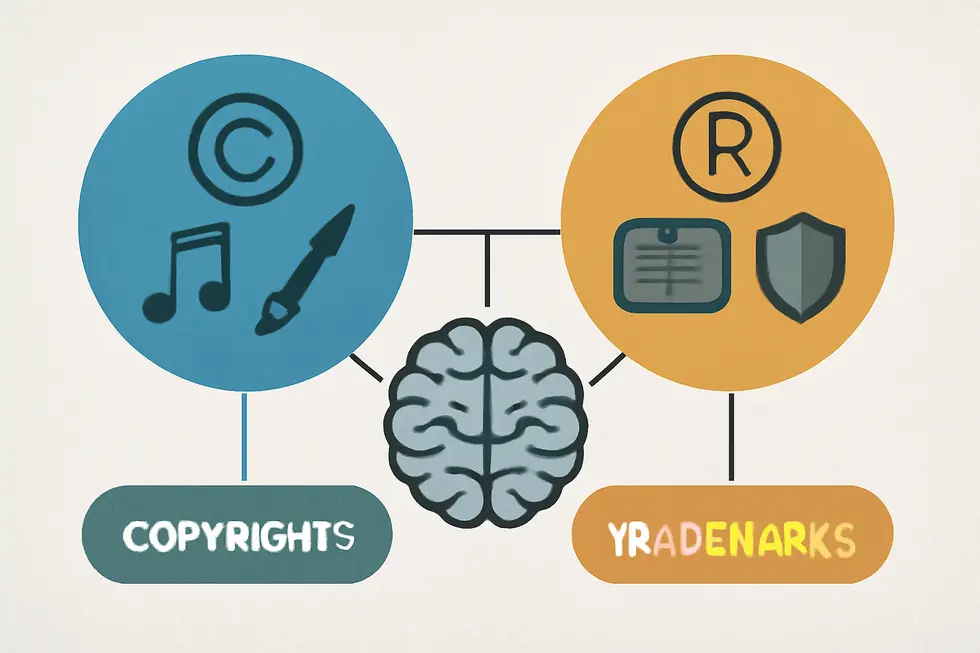
1. The Legal Backbone of Intellectual Property: How Copyrights and Trademarks Secure Creative and Commercial Rights
Copyrights and trademarks serve as fundamental legal protections within intellectual property law, granting exclusive rights to creators and businesses. Copyright arises automatically when an original work is fixed in a tangible form, protecting artistic, literary, and digital creations by regulating reproduction, distribution, and public display. In contrast, trademarks safeguard distinctive commercial identifiers like logos, brand names, and slogans that signal the source of goods or services, generally requiring registration to enforce rights effectively. These legal frameworks incentivize innovation and fair competition by preventing unauthorized use and preserving consumer trust. International agreements, including the TRIPS Agreement, harmonize these protections worldwide, while national laws detail their application. Together, copyrights and trademarks embody intellectual property’s role in securing the economic and reputational interests tied to creations of the mind. For deeper legal insights into copyrights, see this copyright information example for business.
2. Technological Aspects Shaping Copyrights and Trademarks in Intellectual Property
Technological Aspects Shaping Copyrights and Trademarks in Intellectual Property
Copyrights and trademarks protect intangible assets that exist and evolve within technological contexts. Copyrights secure original works fixed in tangible or digital formats, including software, music, literature, and multimedia. These protections focus on the expression of ideas, adapting continuously as new technological media emerge. For trademarks, the rapid growth of digital commerce and communication intensifies their role in safeguarding brand identity through logos, names, and slogans on electronic platforms.
Both rely on technological tools for creation, distribution, and enforcement, reflecting the digital economy’s focus on information-based value rather than physical goods. Industries driven by advanced technologies, such as software and electronic manufacturing, leverage copyrights and trademarks alongside patents and trade secrets to maintain competitive edges. This integrated protection underscores the sophisticated technological environment shaping intellectual property today.
The rise of AI and digital networks imposes new challenges for IP management, demanding updated approaches to enforcement and protection. This evolving landscape highlights how copyrights and trademarks exemplify the crucial technological dimension of intellectual property rights.
Learn more about trademark protections and business identity at trademark protection for business name and logo.
For further insight on competition management in digital times, see: https://www.cigionline.org/articles/managing-rivalry-in-the-digital-era-through-peaceful-competition/
3. The Economic Power of Copyrights and Trademarks in Driving Innovation and Market Success
Copyrights and trademarks stand as vital pillars of intellectual property that drive economic growth by protecting creativity and brand identity. Copyrights grant creators exclusive rights over original artistic and literary works, enabling them to monetize and control their use. Trademarks safeguard brand elements such as names and logos, allowing businesses to build consumer loyalty and distinguish themselves in competitive markets. These protections encourage investment in new ideas and branding, which are key to success in knowledge-based economies. Economically, intellectual property rights generate substantial value, with major companies’ worth often rooted in intangible assets like copyrights and trademarks. For small and medium businesses, these rights create vital competitive advantages, attracting investment and securing returns on innovation. Despite enforcement challenges, copyrights and trademarks remain essential tools fostering innovation, safeguarding business reputation, and underpinning economic vitality worldwide. For further details on economic impacts, see authoritative analyses of the U.S. IP market here.
4. Geopolitical Dimensions Shaping Copyright and Trademark Protections Worldwide
Copyrights and trademarks, as key forms of intellectual property, are profoundly influenced by geopolitical factors that dictate how these rights function across borders. Because IP protections are territorially bound, each country enforces its own rules, reflecting diverse legal traditions and cultural values. International treaties like the Berne Convention and the Madrid Protocol strive for harmonization, yet geopolitical tensions often lead nations to prioritize sovereignty over unified standards. This dynamic affects how copyrights and trademarks are recognized and enforced globally. Moreover, controlling IP rights serves as a strategic tool for nations aiming to lead in innovation and influence global markets, especially in sensitive industries tied to national security. Geopolitical conflicts and sanctions further complicate enforcement, sometimes limiting foreign IP owners’ ability to protect their works. Businesses must therefore navigate intricate geopolitical landscapes to protect and leverage their copyrights and trademarks effectively. For deeper insights, explore international protection and geopolitical impact.
5. The Societal Impact of Recognizing Copyrights and Trademarks as Intellectual Property
Copyrights and trademarks as core forms of intellectual property profoundly shape society by promoting creativity, economic vitality, and consumer trust. Copyrights grant creators exclusive rights over original works, fueling artistic and technological innovation by ensuring authors can profit from their efforts. Trademarks build brand identity and protect businesses by distinguishing products in crowded markets, which fosters loyalty and helps consumers avoid counterfeit goods. This legal recognition supports economic growth by incentivizing quality and uniqueness. As digital platforms expand, safeguarding these rights becomes vital, driving legal frameworks to evolve for clearer protections online. Understanding these protections also influences marketing strategies, encouraging businesses to value intangible assets strategically. For smaller creators and enterprises, this knowledge is crucial in defending their creative and commercial identities worldwide. Ultimately, embracing copyrights and trademarks nurtures an ecosystem where originality thrives, brands remain trusted, and marketplaces remain fair and innovative. For a deeper exploration, visit this comprehensive summary on intellectual property examples.
Chapter 2: The Role of Copyrights and Trademarks as Examples of Legal Protections
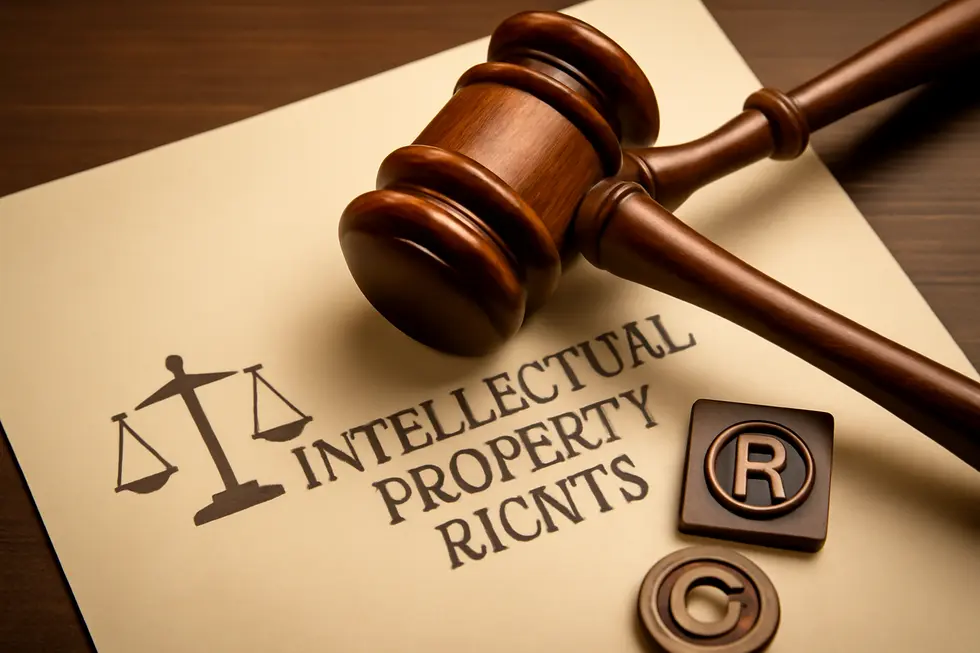
1. Understanding Copyrights and Trademarks: Core Differences in Protecting Creativity and Brand Identity
Copyrights and trademarks are distinct yet complementary legal protections that safeguard intellectual property in different ways. Copyrights protect original creative works fixed in a tangible form—such as books, music, paintings, or software—granting creators exclusive rights to reproduce and distribute their expression. Crucially, copyrights cover how an idea is expressed, not the idea itself, fostering creativity without blocking others from exploring similar topics. In contrast, trademarks protect brand identifiers like names, logos, slogans, and even packaging designs that distinguish goods or services in the marketplace. Their primary role is to prevent consumer confusion by linking products to their source, thereby preserving reputation and trust. Unlike copyrights, trademarks can last indefinitely as long as the mark remains in commercial use and is legally defended. While copyrights automatically arise upon fixation, trademarks benefit from registration but also have common law rights through usage. By defining these clear and fundamental differences, the law effectively balances protecting artistic innovation with maintaining marketplace clarity and consumer confidence. For a deeper look into trademark protections for your brand, see trademark protection for business name and logo. More detailed explanations can be found at Kaway Law[1].
2. Navigating Legal Frameworks and Registration: How Copyrights and Trademarks Secure Intellectual Property
Copyrights protect original creative works such as books, music, and artwork. These rights arise automatically once a work is fixed in a tangible form, granting exclusive control over reproduction and distribution. While registration is not mandatory, formally registering with a copyright office strengthens enforcement and legal standing. In contrast, trademarks safeguard brand identifiers like names and logos that distinguish goods or services in commerce. Trademark rights can begin through actual use (common law) but gain robust, nationwide protection upon registration with offices such as the USPTO. Registered trademarks benefit from legal presumptions of ownership and enhanced remedies against infringement. The legal frameworks differ: copyright law focuses on protecting authorship under statutes like the U.S. Copyright Act, while trademark law, governed by the Lanham Act, emphasizes marketplace source identification and consumer protection. Registration procedures reflect these distinctions—creators submit their work for copyright registration, whereas trademarks undergo examination, opposition, and formal registration stages. These legal protections collectively empower creators and businesses to defend their intangible assets, promote innovation, and maintain marketplace trust. For more insights on trademark registration and protection, visit trademark protection business name logo.
3. Economic Forces and Market Dynamics Shaped by Copyrights and Trademarks
Copyrights and trademarks are vital legal tools that drive economic progress by protecting creators’ and businesses’ intangible assets. Copyrights secure exclusive rights over original works such as books, music, films, and software, granting creators control over reproduction and distribution. This exclusivity encourages investment in creativity, allowing rights holders to monetize their work through royalties and licensing, ultimately fueling cultural innovation while balancing public access. Meanwhile, trademarks safeguard brand identifiers—logos, names, slogans—preserving brand reputation and consumer trust. These protections help companies distinguish products in competitive markets, enhance loyalty, and add significant valuation. Trademarks enable business growth through licensing and franchising, smoothing market entry and attracting partnerships. Together, these protections underpin economic activity by incentivizing innovation, securing market positions, and fostering fair competition. For additional insights on how trademarks shape economic roles, see the trademark protection for business name and logo article and broader economic perspectives here.
4. Navigating Technological Disruptions: How Copyrights and Trademarks Adapt to Modern Challenges
Copyrights and trademarks protect creators and brands, yet the rapid advancement of technology presents continual challenges. Digital platforms have made copying and distributing works easier, complicating enforcement and prompting reliance on Digital Rights Management to safeguard copyrights. For trademarks, the rise of online marketplaces and digital advertising introduces risks of subtle brand infringements that can confuse consumers. Meanwhile, artificial intelligence generates content autonomously, raising novel questions about authorship and ownership that existing laws must evolve to address. Emerging technologies like blockchain offer promising tools for transparent IP management and verification, though legal frameworks need to incorporate these innovations fully. To maintain effective legal protections, ongoing updates to laws and strategic use of technology are essential. This dynamic interplay ensures copyrights and trademarks continue fostering creativity and consumer trust even amid technological disruption. For a comprehensive discussion on adapting IP law to technology, see intellectual property and technological advancement.
5. How Copyrights and Trademarks Shape Culture and Society Through Legal Safeguards
Copyrights and trademarks serve as vital legal safeguards that protect intellectual creations and brand identities, influencing both culture and society. Copyright grants creators exclusive rights over artistic and literary works, encouraging innovation by ensuring economic and moral benefits. This legal framework balances private ownership with public access through fair use, contributing to cultural development worldwide. Conversely, trademarks protect symbols, names, and designs that identify goods or services, preventing confusion and fostering consumer trust. Beyond commerce, trademarks often become cultural icons, shaping social narratives and identity. Together, these protections promote economic growth and legal clarity, safeguarding creators and businesses while enriching cultural heritage. Their interplay underscores intellectual property’s foundational role in sustaining creativity, market integrity, and shared cultural values. For a deeper understanding of trademark protection for business branding, visit trademark protection for business name and logo.
Chapter 3: Differences Between Copyrights and Trademarks as Examples of Intellectual Property Rights
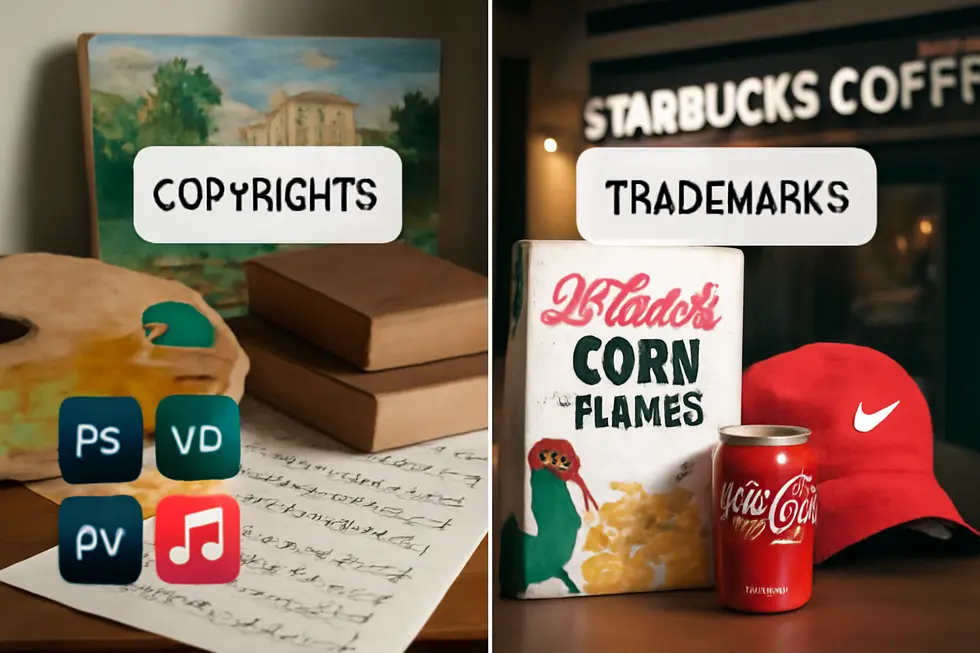
1. Understanding the Legal Foundations Distinguishing Copyrights and Trademarks
The legal foundations of copyrights and trademarks reflect their distinct roles within intellectual property law. Copyright protects original creative expressions fixed in tangible form—such as literary works, art, and music—granting creators exclusive rights automatically upon creation under statutes like the U.S. Copyright Act. It safeguards the expression, not the underlying ideas, lasting for the author’s life plus 70 years, or 95 years for corporate works. In contrast, trademarks protect distinctive signs—names, logos, and slogans—that identify goods or services and arise from use in commerce or formal registration governed by trademark law and unfair competition principles. Trademark rights endure indefinitely if actively used and renewed, focusing on consumer protection by preventing confusion and preserving brand reputation. Together, these legal foundations emphasize copyrights’ role in fostering creativity and trademarks’ role in ensuring commercial identity and trust. For more detailed legal insights, see trademark protection of business names and logos. More comprehensive analyses are available at the U.S. Patent and Trademark Office (USPTO) guidelines.
2. Navigating the Lifespan and Maintenance of Copyrights and Trademarks in Intellectual Property Law
Copyrights provide protection for a fixed period—typically the life of the author plus 70 years for individual creations post-1978. For corporate works, this spans 95 years from publication or 120 years from creation, whichever is shorter. Protection arises automatically once a work is fixed in a tangible form, though registration can enhance enforcement. In contrast, trademarks can last indefinitely, provided the owner continuously uses the mark in commerce and complies with renewal procedures, usually every 10 years. Failure to use the trademark for a few years or neglect renewal filings may result in loss of rights. This ongoing maintenance, including evidence of active use, underscores the dynamic nature of trademarks as living assets tied to marketplace identity. These differences reflect their purposes: copyrights safeguard creative expression for a limited time, while trademarks endure as long as they represent the source of goods or services. For deeper insights on these distinctions, explore trademark protection for business names and logos.
3. Clarifying the Distinct Scope and Subject Matter of Copyrights versus Trademarks
Copyrights and trademarks protect different facets of intellectual property through distinct scopes and subject matters. Copyright covers original creative works fixed in tangible forms, including literary pieces, music, films, art, and software. It safeguards the specific expression of ideas—never the ideas themselves—granting authors exclusive rights to reproduce and distribute their creations. This protection arises automatically upon creation and typically endures for the author’s lifetime plus 70 years. In contrast, trademarks shield brand identifiers like words, logos, and slogans that distinguish goods or services in commerce. Trademark rights usually require registration and are maintained indefinitely through continued use and renewal. Their primary function is to prevent consumer confusion by securing a brand’s unique marketplace identity. Often, a single product benefits from both protections—its creative content covered by copyright while its name and logo enjoy trademark protection. This clear difference reveals how each right serves complementary roles within intellectual property law, securing both creative works and brand reputation. For a detailed overview of protecting business names and logos, see trademark protection for business name and logo. More details can also be found at ebizfiling.com.
4. How Copyrights and Trademarks Shape Business Value and Market Dynamics Differently
Copyrights and trademarks represent distinct economic assets within intellectual property, reflecting their unique roles in business strategy and market competition. Copyrights grant creators exclusive rights over original works like literature, music, and software for a limited time—typically the creator’s life plus 70 years—stimulating innovation by allowing temporary revenue generation through licensing and sales. This finite protection encourages cultural growth and eventually expands access through the public domain. In contrast, trademarks secure brand identifiers such as names and logos indefinitely, as long as they remain in use, fostering sustained brand equity, consumer trust, and competitive advantage. Their indefinite duration means trademarks are considered long-term assets that enhance customer loyalty and market position without amortization, unlike copyrights which are amortized over their economic life. Thus, copyrights primarily drive short- to mid-term economic gains rooted in creativity, while trademarks build persistent value by continually signaling quality and origin. This distinction compels businesses to balance investment in both forms to optimize their intellectual property portfolios. For further understanding of trademark protections, see trademark name and logo protection. External insights on trademark versus copyright economic roles are detailed at https://www.upcounsel.com/trademark-accounting.
5. The Vital Roles of Copyrights and Trademarks in Society and Consumer Protection
Copyrights safeguard original creative works—books, music, art, and software—ensuring creators control reproduction and distribution. This protection fosters cultural growth and innovation while rewarding creators financially, enriching society with authentic content. Consumers benefit by accessing original works and trusting that creators receive due recognition. Conversely, trademarks protect brand identifiers like names, logos, and slogans, helping consumers identify genuine products and services. Trademarks maintain market clarity and consumer confidence by preventing confusion and unfair competition, which sustains brand reputation and product quality. Challenges such as counterfeit goods and misleading online brands highlight trademarks’ crucial role in marketplace integrity. The digital era adds complexity with issues like AI-generated content and social media misuse affecting both copyrights and trademarks. Together, these protections reinforce a balanced intellectual property system that nurtures creativity and trust. For deeper insight, visit trademark2go.com.
Chapter 4: Economic and Societal Impact of Copyrights and Trademarks as Examples of Intellectual Property
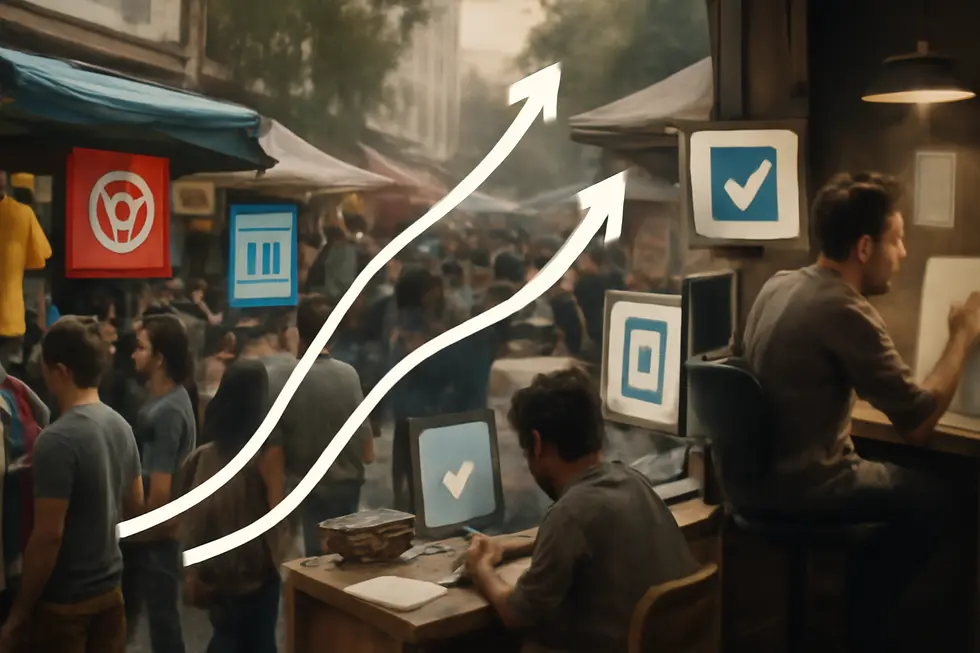
1. How Copyrights and Trademarks Drive Economic Growth and Brand Value
Copyrights and trademarks are at the heart of economic innovation and competitive advantage. Copyrights secure creators’ rights over original works like books, music, and software, enabling them to generate billions through licensing and sales. For instance, the U.S. earned $17 billion in 2024 solely from copyrights tied to movies, television, and sound recordings. This protection encourages investment in the creative industries, fueling economic activity and cultural development. Meanwhile, trademarks safeguard brand identifiers—logos, names, and slogans—that build consumer trust and loyalty. Recognizable trademarks represent quality and reputation, allowing businesses to maintain market share and deter counterfeit products. Together, these intellectual property rights protect valuable intangible assets, which constitute nearly 90% of the top U.S. companies’ market value. This legal framework supports business growth, fosters innovation, and powers international trade of creative and branded goods. For deeper insights on trademark protections, visit trademark protection for business names and logos.
Source: https://www.cigionline.org/articles/the-united-states-biggest-vulnerability-in-the-trade-war-its-knowledge-economy/
2. How Copyrights and Trademarks Enhance Society by Safeguarding Creativity and Trust
Copyrights and trademarks serve as vital mechanisms that enrich society by nurturing creativity and fostering trust in commerce. Copyrights grant creators exclusive rights to their original works—ranging from literature to software—encouraging continuous cultural and artistic development. This legal protection ensures creators can profit from their efforts, motivating ongoing innovation that benefits the public. Meanwhile, trademarks protect distinctive brand identifiers like names or logos, enabling consumers to recognize authentic products and build confidence in their choices. These protections discourage unfair competition and imitation, safeguarding both businesses’ reputations and consumers’ interests. Together, copyrights and trademarks contribute to economic vitality by promoting investment in creative industries and maintaining market integrity. By supporting a diverse cultural landscape and reliable commerce, they play an instrumental role in advancing societal welfare. For more insight into trademark safeguards essential for business identity, see trademark protection for business names and logos.
3. How Copyrights and Trademarks Drive Innovation and Creative Growth in Intellectual Property
Copyrights and trademarks serve as foundational pillars in encouraging continuous innovation and creativity within the realm of intellectual property. Copyrights secure exclusive rights over original creative works like literature, music, films, and software, enabling creators to control reproduction and distribution, which motivates investment in new content. Meanwhile, trademarks protect brand elements—logos, names, and slogans—that distinguish goods or services, fostering consumer trust and prompting businesses to innovate in branding strategies to maintain competitive edges. Together, these protections create a dynamic environment where originality is rewarded, providing economic incentives for authors and companies alike. This legal safeguard fuels sectors ranging from entertainment to technology by assuring creators their work and reputations are shielded from infringement. Challenges like piracy and counterfeiting persist but underscore the need for robust enforcement of IP rights. Ultimately, copyrights champion artistic innovation, while trademarks foster business creativity, both crucial to sustained economic growth and societal progress. For deeper insights, visit trademark protection for business name and logo.
Learn more on this topic at: https://thelawliterates.com/intellectual-property-protecting-ideas-powering-innovation/
4. Navigating Technological Disruption: Evolving Copyright and Trademark Protections in Modern Economies
Rapid technological advances, particularly in artificial intelligence, have reshaped how copyrights and trademarks function as intellectual property protections. AI’s ability to autonomously create works challenges traditional concepts of authorship, inventorship, and ownership, prompting urgent legal reinterpretations. Copyrights struggle to safeguard original content amid the surge of AI-generated material and widespread digital piracy, which can undercut creator revenues and industry sustainability. Similarly, trademarks face new threats as counterfeiters exploit digital platforms, risking brand integrity and consumer trust. Enforcing rights grows more complex with anonymous online infringements and content mass production. To adapt, legal systems are developing frameworks clarifying ownership of AI-created works and employing digital rights management alongside AI tools to detect violations. Innovative approaches like confidential source code deposits are emerging to balance transparency with protection. Strengthening trademark law also remains crucial to preserving brand value in global markets. These adaptations are vital for preserving the role of copyrights and trademarks in fostering innovation and commerce today. For more on AI’s impact on IP, see the in-depth analysis by Gowling WLG, and explore strategies to protect your brand at trademark protection for business names and logos.
5. How Copyrights and Trademarks Shape Global Trade and Economic Growth
Copyrights and trademarks serve as vital pillars in the global economy by protecting intangible assets that fuel innovation and competitive advantage. Countries with robust intellectual property frameworks, like the United States, generate significant revenue from IP exports, underscoring the value of copyrights and trademarks beyond borders. These protections enable creators and companies to monetize artistic works and brand identities worldwide, fostering consumer trust and market differentiation. Emerging players such as China are transforming the international IP landscape, creating a multipolar dynamic that encourages productivity yet complicates harmonization efforts. Trade disputes often center on IP enforcement, revealing how copyrights and trademarks influence diplomatic and economic negotiations. Ultimately, these rights support sustainable economic growth and maintain quality standards globally, highlighting their indispensable role in knowledge-driven markets. For further insight into trademark protections, see trademark protection for business name and logo.
Chapter 5: Comparison of Copyrights and Trademarks as Examples of Intellectual Property Among Other IP Forms
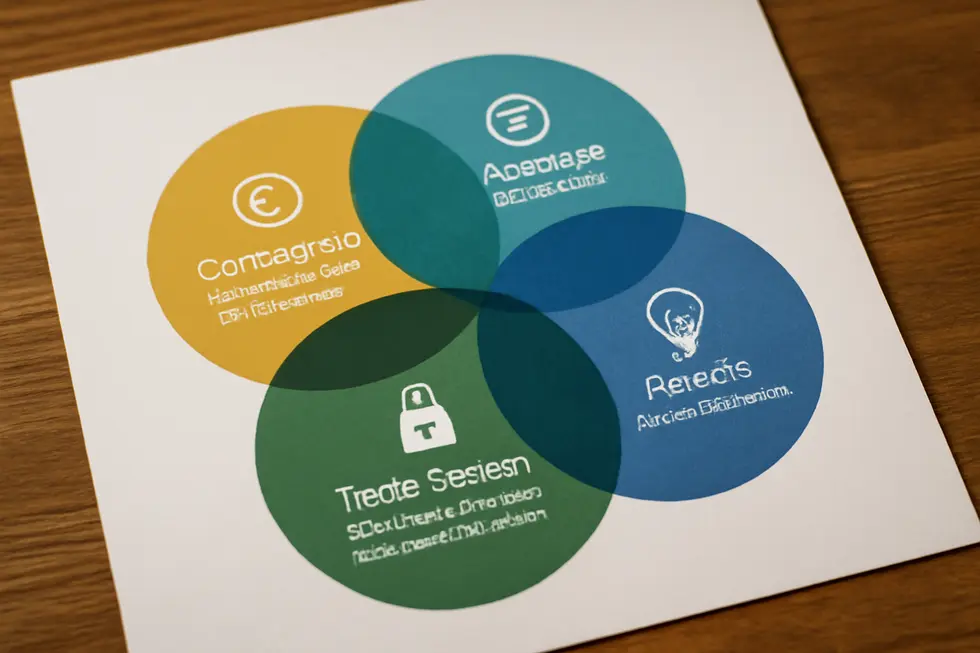
1. Distinct Legal Foundations Shaping Copyright and Trademark Protections within Intellectual Property
Copyrights and trademarks represent two cornerstone legal frameworks within intellectual property (IP) law, each guarding unique intangible assets under differing legal principles. Copyright automatically arises upon the creation of original works fixed in tangible form—such as literature, music, and software—granting exclusive rights to reproduce, distribute, and publicly display these expressions. It primarily protects the expression of ideas, not the ideas themselves, and includes moral rights to preserve attribution and integrity, typically lasting the author’s life plus 70 years. Conversely, trademarks focus on safeguarding brands through distinctive identifiers like names and logos, relying on actual use in commerce and formal registration to confer exclusive rights. Trademark protection is potentially perpetual, contingent on continued use and renewal, aimed at preventing consumer confusion and preserving business goodwill. Together with patents and trade secrets, these protections establish a complementary legal mosaic that advances creativity, commerce, and innovation. For a deeper understanding of brand protection through trademarks, see trademark protection for business name and logo. For comprehensive global copyright standards, the Berne Convention remains the fundamental international treaty.
2. Distinct Economic Contributions of Copyrights and Trademarks in Intellectual Property
Copyrights fuel the creative economy by granting exclusive rights to authors, artists, and developers, enabling them to monetize original works like books, music, films, and software. This protection encourages substantial investment in creative industries and combats piracy, which causes significant financial losses worldwide. By securing income through licensing and sales, copyrights support continuous cultural innovation and sustain numerous jobs. Trademarks, conversely, deliver economic value by safeguarding brand elements such as names, logos, and slogans that build consumer trust and loyalty. This protection allows companies to differentiate their offerings, command premium pricing, and deter counterfeit products that may damage brand reputation and consumer safety. The indefinite duration of trademarks, when maintained, ensures long-term business identity and competitive advantage. Both IP forms stimulate economic growth through direct exploitation, licensing, market differentiation, and innovation incentives, forming vital pillars in the global economy. For deeper insights, see Understanding Categories of Intellectual Property Rights.
3. How Technology Shapes Protection and Enforcement of Copyrights and Trademarks
Copyrights safeguard original creative works like literature, music, art, and software code, focusing on expression rather than ideas or functions. Technological advances have transformed how these works are created, distributed, and infringed upon. Digital platforms facilitate easy copying and sharing, increasing infringement risks and necessitating tools such as digital rights management to enforce protections.
Trademarks, in contrast, protect brand identifiers including logos, names, and slogans that distinguish commercial goods and services. Technology influences trademarks by expanding brand exposure through digital marketing, social media, and e-commerce. Emerging innovations like blockchain are being explored to authenticate trademark ownership and track unauthorized uses in real time, enhancing enforcement against counterfeiting and online impersonation.
While copyrights typically last the author’s lifetime plus 70 years, trademarks can be renewed indefinitely as long as the mark is actively used. These technological dynamics highlight the distinct but complementary roles of copyrights and trademarks in intellectual property law, especially in digital environments. For an insightful guide on protecting brand identifiers, see trademark protection for business name and logo.
More detailed exploration of these frameworks is available at ebizfiling.com.
4. Navigating International Intricacies: How Geopolitics Influence Copyright and Trademark Protections
Navigating International Intricacies: How Geopolitics Influence Copyright and Trademark Protections
Copyrights and trademarks, as integral forms of intellectual property, are profoundly shaped by geopolitical factors that dictate their protection and enforcement globally. While copyrights automatically protect creative works under treaties like the Berne Convention, and trademarks rely on registrations governed by frameworks such as the Madrid Protocol, differing national laws and political priorities complicate uniform enforcement. Geopolitical tensions often influence how countries adjust IP laws to foster economic security and technological dominance, extending strategic leverage especially through patents but also through brand and creative asset protections. Trade disputes and national security concerns further fragment IP enforcement, introducing export controls and data localization requirements that challenge seamless IP commerce. Companies must thus craft nuanced strategies to address this fractured landscape, balancing legal compliance with geopolitical realities. This interplay underscores the necessity of understanding geopolitical contexts when comparing copyright and trademark protections among intellectual property types.
For in-depth guidance on trademark protections for business identity, see trademark protection business name logo.
5. Cultural Resonance and Social Roles of Copyrights and Trademarks Within Intellectual Property
Copyrights and trademarks serve distinct societal and cultural functions that influence their role within intellectual property (IP). Copyrights primarily protect creative works—literature, music, and art—emphasizing the creator’s right to control and benefit from their expression. This protection fosters cultural participation and promotes social justice by enabling equitable access and empowering diverse voices, especially from marginalized communities. In contrast, trademarks identify commercial goods but often transcend their economic purpose to become cultural symbols reflecting societal values and identities. Famous trademarks evolve into icons that shape social narratives, making them subjects for parody and critique, which highlights tensions between commercial interests and freedom of expression. Additionally, Indigenous intellectual property rights focus on protecting collective cultural heritage, underscoring the need for frameworks respectful of communal ownership and cultural sovereignty. On the global stage, international agreements reveal conflicts between developed and developing countries over IP’s societal impact, raising concerns about economic inequality and cultural imperialism. Understanding these dimensions is essential to crafting IP policies that balance protection with cultural respect and social equity. For more insights on trademark roles in business, see trademark protection for business names and logos. External reference: Institute for Intellectual Property and Social Justice.
Final thoughts
Copyrights and trademarks stand as foundational examples of intellectual property that empower business owners to safeguard their unique creations and brand identities. Understanding their specific protections, distinctions, and roles within the wider IP landscape equips businesses to strategically manage their intangible assets. The economic and societal value these protections generate underscores their importance not only for individual enterprises but also for fostering a dynamic, innovative marketplace. By recognizing copyrights and trademarks as critical legal tools, business owners can build lasting value, maintain competitive advantage, and contribute to a thriving economy driven by creativity and trust.
Your IP is the foundation of your success – let’s protect it together before it’s too late. We can’t wait to help you turn your ideas into legally secured assets.
About us
undefined


